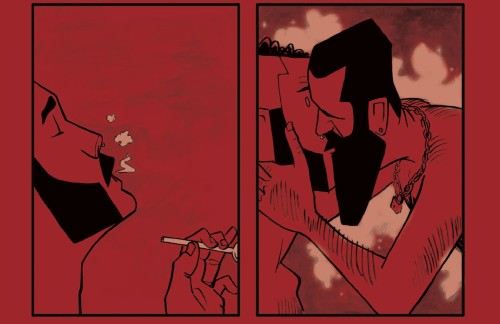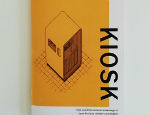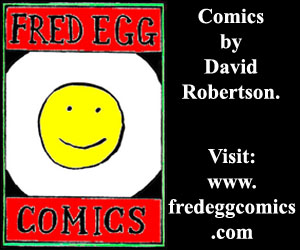HCZF MONTH! Ed Firth is a newer name on the UK indie comics circuit but one we are sure will be coming to far greater prominence in the immediate future. Firth’s debut work was shortlisted for the Myriad First Graphic Novel Competition and earlier this year we reviewed his first self-published comics collection Horny & High Vol. 1. As part of our Hackney Comic + Zine Fair coverage I spoke to him about his uncompromising explorations of the darker side of gay sex culture, his artistic process, and the social responsibility of issue-led comics…
ANDY OLIVER: Before we talk in more depth about your comics can you tell us a little about your wider artistic background and practice as a quick introduction to the Broken Frontier readers?
ED FIRTH: I’ve only been writing comics for a couple of years; but for the past 10 years I’ve been a portrait artist, putting out an annual zine and running a weekly life drawing session. Before that I was in moving images, making projected visuals for bands and theatre. I’ve always written and drawn; I was making little picturebooks and zines when I was a child, I always felt very excited by books and the process of making them.
AO: I recently reviewed the first volume of Horny & High, your graphic-novel-in-progress, at BF. What’s the premise of the book and what are the themes you’re exploring in its pages?
FIRTH: Horny & High is my graphic novel project, a collection of interconnected stories about hooking up in London. The subject that interests me the most at the moment is chemsex. It’s adjacent enough to my own life to make a compelling subject I feel a need to explore and explain to some degree. I don’t know if metropolitan gays are more promiscuous than anyone else but sex is very easily available to to us, or at least feels like it’s within grasp, thanks to apps and cameraphones. It’s something many people are thinking about but a lot of mainstream art and media only touches on it obliquely or incidentally, and I want to really get my teeth into the subject and look at how desire can shape your life, alter the path of your day, how the act of sex can be confronting, therapeutic, triggering, restorative, vulnerable, all kinds of things. I’m interested in how things like class and race and income intersect – we might pretend these things have nothing to do with sex or love, but they factor in to our decision-making and our tastes, and our behaviour.
AO: Horny & High examines a darker side of gay sex culture and chemsex. What is it about comics as a form that made it your particular medium of choice for this narrative and why is it so important to be telling this story now?
FIRTH: I wanted to make a comic that could express some of those emotions around sex that can feel quite profound and paradigm shifting, and I think comics can be more explicit than film or theatre, which are collaborative events that have to make a lot of money back by appealing to a broad demographic, and usually sex scenes are brief and perfunctory – the story doesn’t benefit from the sex, but the film’s marketability does. In theatre it’s awkward and weird to sit through sex scenes and the actors have to do it night after night, and ultimately what’s titillating to one person is repellent to another, so like comedy it’s subjective and hard to create the same feeling for a broad audience without playing broad, and playing into heteronormative values. Comics have a limited audience anyway, it’s expected for you to do something personal, weird – indie comics makers are often very alienated people who enjoy spending a lot of time alone with their imagination!
I’ve read some profoundly moving comics that cover sexual experience frankly and explore its reverberations – Blankets by Craig Thompson, Becoming/Unbecoming by Una, and Adrian Tomine’s Summer Blonde collection are a few that come to mind. Ultimately I’ve committed myself to writing things I would want to read, where you kind of turn the pages in disbelief, and wonder what kind of person would be this frank and bizarre, sitting there drawing all these panels of idiosyncratic, graphic, stylised confession. I’ve seen some plays about chemsex, such as Paul Harvard’s ‘GHBoy’, that have explored interesting themes about sexual identity and internalised homophobia. I think I would like to write and produce a play because of the way ideas come up during rehearsals, and that thrilling way each actor can bring something to their role which you may not have thought of, so you keep refining and working to the performers’ strengths – and someone else takes care of the lighting, costumes, blocking, props, etc., instead of me having to spend half my life doing image research and the other half figuring out how to draw those same things from multiple angles.
Chemsex is a big and largely unacknowledged problem in queer culture. If you go on grindr you see lots of profiles hinting or outright declaring they’re looking for an “HnH” hookup, which in itself is not necessarily a bad thing but if you read the comic you can see that things can slide for people, especially with really potent drugs like meth that give people the energy and drive to keep playing all weekend, or all week, with no sleep, not taking care of themselves or their life admin, missing work, losing their job, their home, their friends, families, support network, mental health, and their teeth. And as with any dangerous situation, there are people who know their limits and can dip in and out unscathed. How long they can keep that delicate balance is the game they’re playing!
People die playing this game, and it’s tragic but as a writer there’s a fascination with the idea of the seed of our destruction being woven into the fabric of our desire. Sex parties or group sex was always a part of queer culture (not for everyone, but it’s in the mix) but the harder drugs that are easily available now bring physical decay and death into the perfectly normal culture of sexual expression. The drugs are mainly a way of easing the discomfort of being gay and sexual in a culture that is still hostile to both. But people should throw away those drugs and pick up a hard-hitting indie comic – that’s the greatest aphrodisiac known to science.
AO: You were shortlisted for the 2020 Myriad First Graphic Novel Competition. How key was that in terms of both the recognition it gave you and in raising the profile of the project?
FIRTH: I honestly don’t know if the Myriad shortlist has made any difference to how the comic was received because it’s my first release! I will have to make a control test comic which gets no critical acclaim and then compare its ascension with the first one. I don’t know if I want to be published by anyone else yet to be honest, I like working to my own deadlines and keeping all the money! I intend to get my work translated into French, Dutch and German to bring my work to audiences on the Continent, and for that it would probably be better to have a publisher overseeing distribution overseas. But right now I’m not convinced working with a UK publisher would pay great dividends – what I’m making is very niche, it’s not upbeat, easily digestible, or cute, and it’s not a genre piece, and it’s not written to appeal to straight people. Former Comics Laureate Hannah Berry’s survey into the industry last year was a major eye-opener; on the whole publishers in the UK don’t seem to know how to market comics, and don’t seem very motivated to make money for comics makers.
AO: The first volume of Horny & High is a very bleak read in places and there’s obviously a great importance with subject matter like this in terms of depicting events with accuracy and care. How do you approach that element of social responsibility that is a core part of topical or issue-led comics?
FIRTH: It would be disingenuous to set a story in the chillout scene and not show how hazardous and damaging it can be, and it would be equally disingenuous to portray the scene and not show the fun and games. As a reader I want fiction to take me places where I might be scared to tread, and as a writer you have to look inside yourself for those places and externalise them and set stories there. And I want these stories to be useful to people, to help them articulate something within themselves, or show them that someone else has felt the same things. I was very conscious that my story was going to sensitive places and I had to be aware of what the work might be suggesting – I don’t want to demonise, sensationalise or marginalise anyone. But the lure of sensation to the marginalised is the beating heart of chemsex and it can lead to some demonic behaviour!
At various points in the project I’ve spoken with Stephen Collins, the chemsex lead at HMPS, who counsels and supports people face to face who have entered the prison service after crimes connected with drug-related and sexual violence, for example committed during drug psychosis. Really heavy stuff, and those people need all kinds of emotional support and empathy, even if a large part of society might think they don’t deserve it. He posts a lot of quotes and excerpts on social media about self-forgiveness and acceptance of past deeds which have given me a lot of food for thought, and have formed the basis of my ideas for Chillout 3. I’ve also been very grateful for the support of David Stuart, the chemsex lead at Dean Street Clinic. The first person I showed the comic to is one of my life models, a very artistically erudite and articulate performer who came out as HIV positive and a chemsex survivor whilst I was writing the first volume. I knew he was exactly the kind of person I needed to check in with before publishing, and we discussed everything I thought might be contentious or potentially offensive.
I’m writing for a gay audience who have some familiarity with or awareness of this world, but I find ways to signal what’s going on for the uninitiated so they can google it to catch up. In Chillout 2, which I’m inking now, someone describes themselves as undetectable – I know that’s going to mean nothing to most straight people, but most gays will understand, and whilst I’m not trying to appeal outside my own culture, I’m not actively trying to alienate anyone either. I want people to gain a grasp of how intense this scene can get, and draw their own conclusions. So yes I do feel a certain responsibility about conveying the extremes of this community to an audience. Vol. 1 has found its way on to a curriculum at the University of Maryland, and apparently the comic is a hit with the staff at Dean Street Soho – and they’re the people who are picking up the pieces and trying to steer people away from the abyss. One friend said to me I’d written a Daily Mail-reading homophobe’s nightmare. Respectability politics has to go out of the window when you’re writing honestly about issues that require empathy, compassion and immediate action – as with AIDs activism in the late 20th century, Silence = Death. I’m not going to keep it palatable and safe. I like stories that unsettle the reader and make them examine their assumptions.
AO: There’s a certain angular realism to your art and a nuanced use of visual characterisation that ensures readers connect immediately with the cast despite their sometimes almost nihilistic worlds. I was also very struck by your use of colour to emphasise mood and/or theme. Can you elaborate on your artistic process and the mediums in which you work?
FIRTH: The way I draw comics is a far less precise and perfected version of my portraiture style. I do like long angular lines, and if it wasn’t for the promise of some nice lines to draw, I don’t think I’d be doing comics. It’s like when the scissors glide through wrapping paper or you get a nice long note to sing in a chorus, little moments of ecstasy. I find realism in pictorial representation extremely boring and frustrating to draw, but I want to write realist stories, so that tension is always simmering in the backgrounds.
When designing the story I look at how each element progresses, contrasts with or adds depth to the narrative, and colour tends to be the last detail, the nice relaxing bit you do in Photoshop. I wanted a predominantly red, carnal, passionate, inflamed shade for the central section of Chillout, and for the world outside to be comparatively drab. I also wanted the main light source to be the porn on the projector. Lots of people have complimented the colour in that story, and honestly it was a result of me not knowing what the hell I was doing. I get some flak from other artists about my colour choices because I tend to randomly pick some that I like, with no theory or design, change them around a bit, then settle. For the current project I’m using online colour generator Coolor.com, I found it at random and have settled on it. If you look at the piece I made for the Ink Well outdoor show, you’ll see my first properly balanced colour palette. That’s how I’m doing things from now on, using the tech instead of relying on guesswork.
AO: I first discovered your work through one of the WIP Comics anthologies. How vital has that group been in terms of providing a supportive network as you have navigated the UK indie comics scene?
FIRTH: WIP is such a fantastically supportive and exciting group to get involved with. I put off joining for four years because I told myself I couldn’t go until I’d drawn a comic. Getting started was really hard! I should have just gone – on my first meeting there we were sharing our work and some people had nothing but some ideas, or some sketchbook drawings, and just from being around other people who were a little further down the path, they felt energised and permitted to start making and writing. I would probably be on my tenth comic by now if I’d gone sooner. Over lockdown I founded QWIP!, a Queer Work In Progress group, to bring together some really interesting and diverse creators on Zoom once a month. But it’s supplementary to the WIP group, it’s not a renegade faction. I just wanted a smaller, queerer space where people can feel supported and safe with their creativity and also encouraged to tell those dangerous stories that feel exposing.
AO: And finally what else are you currently working on? What can we expect to see next from Ed Firth?
FIRTH: As mentioned, I’m currently inking Chillout 2, which has grown so big it A) won’t be finished in time for Thought Bubble, where I’ll be tabling this year, and B) is taking up all of volume 2 of Horny & High. So my next release will be the first 10 or so pages of Chillout 2, in which Stu, having learned the dangers of chemsex, gets straight back into it. I’d like to risograph print it because I just love that glowing quality of the inks, you can’t reproduce it with conventional lithograph book printing. And then HnH vol 3 will be short pieces again; I would like to spend 2022 producing short comics, 3-10 pages, about some of the other characters we’ve met in the stories so far.
You can find Ed Firth in Hall Two at HCZF. Follow HCZF on Instagram (@hackneycomicfair) and Twitter (@hackneycomics) for updates, and head over to www.hackneycomicfair.com for more information about the event.
For more on Ed Firth’s work follow him on Twitter here and Instagram here. You can buy Horny & High from his online store here.
Interview by Andy Oliver























[…] Oliver talks to Ed Firth about Horny & High, expressing intense emotions via the comics form, the dangers of chemsex, […]